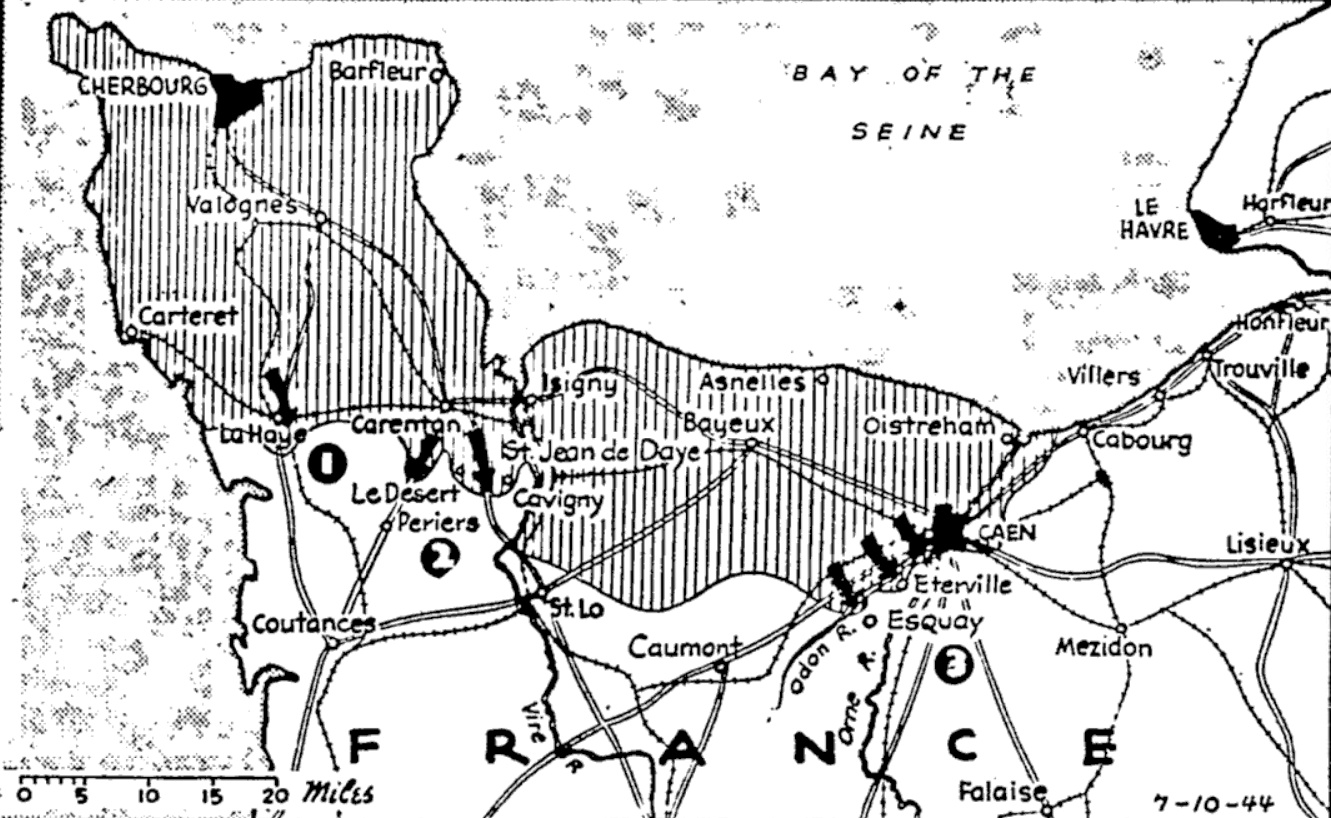The Pittsburgh Press (July 10, 1944)
British capture three towns, key height south of Caen
Yanks advance mile, extend bridgehead in central Normandy

Two initial objectives captured, Caen and La Haye-du-Puits, British and U.S. forces today continued to advance along the road to Paris. The Yanks pushed 2,000 yards south of La Haye (1), captured the towns of Le Désert and Cavigny and drove to within five miles of Périers (2). The British and Canadians extended their beachheads across the Odon River, captured three villages and a key height, and pressed toward the Nazis’ Orne River line (3).
SHAEF, London, England –
British and Canadian forces slashed into the exposed German flank below captured Caen today and drove forward through three fortified villages to within less than half a mile of the Orne River defense line due south of Caen.
Gen. Sir Bernard L. Montgomery’s 2nd Army, striking again while the mop-up of the Caen area was underway, stormed through Éterville, Maltot (near Esquay) and Bretteville-sur-Odon in advances up to about a mile and overran the hotly-contested height called Hill 112 commanding the Orne–Odon salient below Caen.
U.S. forces advancing down the mid-Normandy highway toward Périers captured Sainteny, five miles southwest of Carentan, and other U.S. units expanded the bridgehead across the Vire for an average gain of a mile, reaching a point only 7,000 yards from Saint-Lô.
The expansion of the Vire bridgehead almost brought the front in line with the general battle zone through the Caumont–Saint-Lô area, and a headquarters spokesman said Lt. Gen. Omar N. Bradley’s drive there “shows considerable long-term promise.”
Threaten encirclement
The British-Canadian armored force cutting in below Caen like a giant scythe began developing a possible encirclement maneuver against the German troops holding out in the Faubourg-de-Vaucelles, southern suburb of Caen.
The high ground captured by the Imperials between the Odon and Orne Rivers was the key to the entire Caen sector, and the victory put the final seal of the conquest of the great inland port.
A spokesman, however, emphasized that the Germans were still fighting fiercely all along the Normandy front, but had been obliged to throw in reserves they had been trying to build up for a showdown.
Orderly withdrawals
It was emphasized that wherever the Nazis were giving ground, they were doing so by orderly withdrawals, and nowhere was there a sign of disorganization in the enemy ranks or large-scale disengagement.
With the seizure of Hill 112 between the Orne and Odon, the British were able to command the highway running south and slightly west from Caen, leaving only the Caen–Falaise highway in German hands and relatively free of interference.
In the immediate area of Caen, which fell yesterday, German strongpoints which had been bypassed in the final assault on the city were being cleaned out.
Counterattacks held
West of Caen, the Germans counterattacked, but were held everywhere by the British.
The Americans who captured Sainteny pressed on down the road from Carentan toward Périers, the road hub controlling the territory between Saint-Lô and the west coast.
To the northwest, the Germans counterattacked strongly in the area of La Haye-du-Puits, captured yesterday, but the Americans beat off the blows and destroyed a number of enemy tanks.
Front dispatches disclosed that Gen. Montgomery’s tanks and infantry, supported by warships and rocket-firing planes, had cleared a six-mile stretch of the north bank of the Orne in Caen and on either side of the city.
Couldn’t wreck bridges
A headquarters spokesman said the final stages of the British advance into Caen were so rapid that the Germans were not believed to have had time to destroy all the bridges across the Orne.
The British first pushed across the Odon River some five miles southwest of Caen nearly two weeks ago and so developed their threat to the Orne River that the Germans committed a major portion of their armor there.
The line swayed back and forth during five German counterattacks, but the British held firmly to their bridgehead.
Americans also advance
One column of the U.S. 1st Army at the western end of the 111-mile front pushed 2,000 yards south of La Haye-du-Puits, another seized Le Désert and Cavigny, three miles southwest and three southeast respectively of Saint-Jean-de-Daye, and a third drove down the Carentan-Périers road.
Headquarters acknowledged that the Germans had made a minor gain in violent counterattacks on the Mount Castre plateau southeast of La Haye, though the Americans still held high ground there.
The liberation of Caen cleared away one of the strongest obstacles on the highway and railway from Cherbourg to Paris 120 miles to the east, and gave the Allies a first-class port which had a peacetime capacity of two million tons of cargo a year. Caen, the largest city yet captured by the Allies in France, had a peacetime population of 50,000, some 20,000 more than Cherbourg.
Once well across the Orne, however, Allied armor can fan out across rolling country without a natural defense obstacle for 20 miles. Any German attempt to make a stand short of a ridge running northwest from Falaise, 20 miles southeast of Caen, to the Caumont area was expected to touch off an armored battle that may determine the length of enemy resistance in western France.
Caen was little more than a crumbling mass of ruins when it fell into British hands yesterday, but its port installation and the Orne Canal leading seven miles northward to the sea were believed largely intact.

